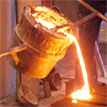
Molds are made from sand (a mixture of silicon sand, carbon? and water). A model of the desired part (called a pattern) is made from wood, plastic or metal. The pattern is placed on a plate and the sand is pressed around it to form the mold.
After casting the mold is destroyed and the cold part can be cleaned and entry runner cut away. Due to slip angles and rough surfaces is additial machining often required.
Danish Name
Category
Materials
Typical products
Frying pan
Price notes
Environmen- tal notes
Keywords
Holow parts
Photo
Copyright
This page is part of Design inSite
Disclaimer